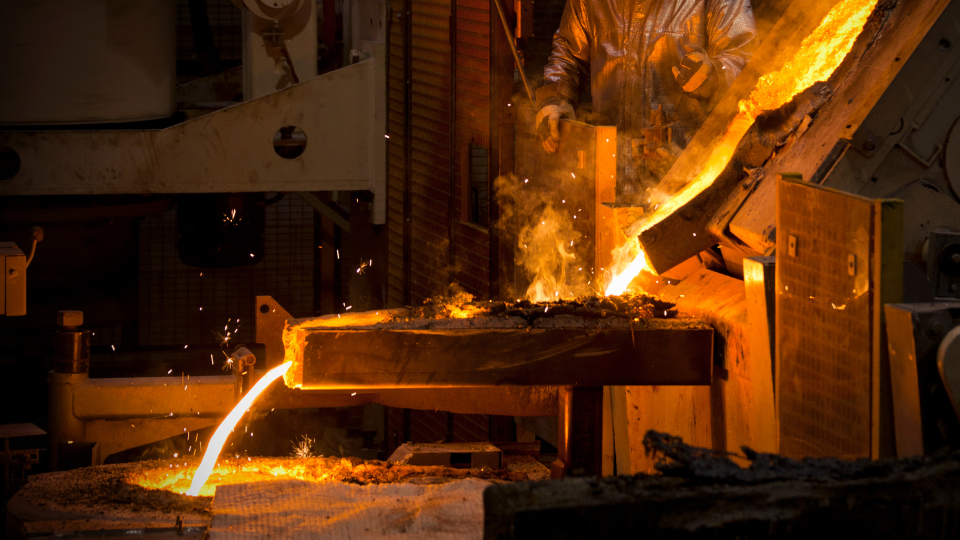
In foundries, controlling the temperature of molten metal is critical to achieving high quality castings and improving yield. Small variations in pouring temperature can lead to significant defects, wasting time, materials, and resources. By understanding the kinds of issues that can result from improper temperature control, foundries can take steps to prevent them and increase operational efficiency. This article explores how precise temperature control can reduce casting defects and boost yield in the metal casting process.
Temperature-Related Defects in Castings
Improper temperature control during the pouring process can create a variety of defects that compromise the structural integrity and performance of a final product. In this section, we will examine common temperature-related casting defects.
Cold Shuts
Cold shuts occur when two fronts of molten metal fail to fuse correctly. This results in a visible line or a weak area within the casting. This defect is often caused by pouring metal at too low a temperature. When molten metal cools too quickly during the pouring process, it can lose the fluidity required to fill molds completely. Maintaining the correct pouring temperature ensures the metal remains liquid long enough to fuse seamlessly, avoiding cold shuts.
Shrinkage Defects
Shrinkage occurs when metal contracts as it solidifies, sometimes leading to internal cavities or surface depressions. If the metal is poured at too high a temperature, the solidification process is delayed, causing shrinkage cavities. This defect is particularly problematic in larger castings where uneven cooling can exacerbate the issue. Proper temperature control helps balance solidification times, ensuring the casting forms as expected without excess shrinkage.
Gas Porosity
Gas porosity refers to small voids or bubbles within a casting, which weaken the structure. When metal is poured at excessively high temperatures, it can absorb gases like hydrogen or oxygen. In steel, for example, high temperatures increase the risk of hydrogen absorption, leading to gas-related defects such as blowholes, pinholes, and fissures. Controlling the temperature during pouring helps minimize gas absorption, creating denser and more reliable castings.
Hot Tearing
Hot tearing is a defect that occurs when a casting develops cracks due to uneven contraction as it cools. If the temperature during pouring is too high or uneven, certain areas of the casting cool at different rates, creating stress fractures. Controlling the pouring temperature ensures a more uniform cooling process, minimizing the likelihood of hot tearing.
Oxide Inclusions
Oxide inclusions are impurities that become trapped inside the casting. These inclusions can form when molten metal oxidizes as it is poured into the mold, which often occurs due to excessively high pouring temperatures. Oxidation degrades the quality of the final product, weakening the casting and reducing yield. Pouring at optimal temperatures minimizes the formation of oxides, leading to cleaner, higher quality castings.
How Temperature Variations Affect Yield
Defects caused by poor temperature control not only degrade casting quality but also impact overall yield. Defective parts often require reworking, additional material usage, or outright scrapping. This leads to increased costs, longer production times, and wasted resources.
Shrinkage cavities, gas porosity, and oxide inclusions, in particular, can render castings unusable, forcing foundries to restart production on a part. This lowers overall yield and drives up operational costs. By maintaining optimal pouring temperatures, foundries can reduce defect rates and improve yield, making their operations more efficient and cost effective.
Best Practices for Temperature Control in Foundries
To minimize defects and maximize yield, foundries need to implement rigorous temperature control strategies throughout the casting process. Best practices include the following:
Real-Time Temperature Monitoring
Foundries should invest in tools like digital pyrometers to monitor molten metal temperatures in real time. By continuously measuring temperature, operators can ensure the metal is poured within the optimal temperature range, reducing the likelihood of temperature-related defects.
Thermal Analysis Systems
Thermal analysis systems measure the cooling curve of molten metal, providing essential insights into solidification times and melt characteristics. This data helps operators adjust temperature settings to optimize casting quality and yield.
Probes and Sensors
Immersion probes designed to measure hydrogen, oxygen, and temperature provide critical information about the molten metal’s composition. For example, SYSCON’s temperature probes help foundries maintain precise temperature control during the refining process, and oxygen and and hydrogen probes can monitor and prevent issues like gas porosity.
Achieving Optimal Pouring Temperatures for Different Metals
Each metal and alloy has its own specific temperature range that must be maintained to produce quality castings. For example,
- Pouring iron at precise temperatures is crucial to managing shrinkage and ensuring proper eutectic reactions.
- In steel production, tight control over pouring temperature is necessary to avoid hydrogen-induced gas porosity.
- Pouring aluminum within the correct temperature range prevents the formation of oxides and cold shuts, helping to ensure defect-free castings.
SYSCON Sensors for Temperature Control
Achieving the correct pouring temperature every time is a challenge for foundries, but one that can be effectively managed with the right tools. SYSCON Sensors offers a range of reliable temperature measurement and thermal analysis solutions that help foundries monitor and control molten metal temperatures.
Our TS-1 handheld digital pyrometer and WM-1 wall-mount digital pyrometer provide real-time temperature readings, ensuring that operators can maintain optimal pouring temperatures. For more advanced thermal analysis, the FL-1 thermal analysis system delivers accurate cooling curve data, helping foundries fine-tune their processes to reduce defects and improve yield.
By investing in high quality temperature measurement tools from SYSCON Sensors, foundries can significantly reduce the occurrence of temperature-related defects, improve casting quality, and increase overall yield. Browse our blog to learn more about finding the perfect tools for your operation.


